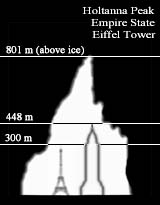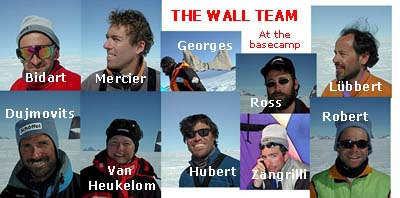|
From
Jessica - Class of Catherine Pellaton, Ecole des Tattes.
Q: How will you be spending Christmas and the New Year?
A: We celebrated Christmas all together in the big mess tent
in the base camp, and we will do so again for the New Year.
Ralf had a cake, René some chocolates, I had brought some foie
gras and Alain Hubert cooked the meal, meat and fish pancakes.
We celebrated Christmas as everywhere else on the planet even
though we were isolated in the Antarctic.
From
the Barberêche Primary School.
Q: How are you feeling now that you are there, are you
well?
A: The living conditions are not as easy as in Europe, but we
adapt pretty quickly, and rapidly to the cold as well. So we
are very pleased to be spending two months in this unique, fantastic
environment.
Q: The lavatories are in an igloo … but how do you avoid
freezing when you use them? A: In fact the igloo protects
us from the outside cold and always maintains roughly the same
temperature (about -5°C), so we don't freeze when we go to the
lavatory. Having an igloo for the lavatory is a great luxury
for an expedition such as ours.
Q: How do you manage to wash?
A: In fact we do not wash, except for our faces and hands, and
for cleaning our teeth. Washing in the open air would be too
unpleasant and would require too much hot water which is precious
because it takes a long time to make it from snow. In any event,
we don't really perspire in the Antarctic, so we hardly get
dirty.
Q: Do you suffer from the cold ?
A: Yes and no. Since we arrived in Antarctica, most of the days
have been fine. On days like that, when the sun shines, it is
about -7°C., which is entirely bearable, if not pleasant, because
the humidity is very low, and so we don't need to wear too many
clothes. On the other hand, when the sky is overcast or the
sun goes down, the cold arrives very quickly and we have to
cover up because that is when we can suffer from the cold.
Q: Have you come across any living creatures since your
arrival?
A: Yes, birds. We have seen lots of snow petrels in the mountains
and nunataks, and we have also spotted some skuas.
Q: What have the highest and lowest temperatures been
since you arrived?
A: The lowest temperature must have been about -25°C during
the night, that is to say when the sun is lower than the horizon
(but never set). During the day, the highest temperature has
been about -4°C. We should add that, in the morning, the sun
warms up the tent and the temperature inside it can climb as
high as 30°C, which is not very nice when we have adapted to
the low temperatures.
Q: What do you eat?
A: Mainly rice, pasta, fish, diced bacon, sausage, instant soups,
cheese, dried fruit and chocolate. Each evening, the team members
take turns to make the meal. Each is therefore faced with the
challenge of making a meal that is different from the previous
one, with the same food.
Q: Do you have enough to eat?
A: Yes, for the most part. Alain bought about 800kg of food
for the expedition!
Q: What kind of instrument do you use for a telephone?
A: We telephone with an Inmarsat communication system that works
with the help of satellites orbiting around the Atlantic and
Indian oceans.
Q: Do you have a lot of spare clothing?
A: We do not have as much as when we are living in Europe, for
in the Antarctic, because of the low temperatures and the low
humidity, we perspire much less and therefore hardly soil our
clothes.
Q: How do you wash your clothes? A: We don't
wash them: when they are a little damp, after a long march,
for example, we dry them by hanging them on a line in the tent.
Q: Do you miss your families?
A: Yes, and of course especially during the Christmas period,
but we are extremely busy and only think of them from time to
time.
Q: How strong have the most violent winds been since
your arrival?
A: The strongest winds have been about 60 kph, which is not
unusual for the Antarctic.
Q: Can the tent that you sleep in get blown away?
A: I hope not! We have done everything we can to make it withstand
the great winds: the ropes are maintained by bamboo sticks that
are buried deep in the snow and we have built a wall of snow
around each one. But if ever we were to experience a major storm,
we would nevertheless not have a very relaxing night.
Q: Have you had any serious problems or accidents since
your arrival?
A: No, fortunately, there have been no problems.
Q: Is it possible for you to fish?
A: No, because we are a long way from the coast (200 km).
Q: Have you seen the Aurora Borealis?
A: Unfortunately not, because there is daylight all the time
and you need the night to see them. It is the teams that spend
the winter in the scientific stations that can generally admire
the spectacle.
Q: For how many hours do you sleep?
A: Depending on the day, between 5 and 10 hours. It depends
on what we are doing, and on the weather, but also on our ability
to go to sleep in the daylight. For my part, (Editor's
note: it is the French researcher Alain Bidart who is answering
the youngsters' questions), I sleep with a blindfold
over my eyes to keep out the sunlight.
Q: Do you have any free time, and if so, how do you spend
it?
A: Now and again, and when the moments occur, we read or we
write our diaries - which is traditional for polar explorers.
Q: What do you do to measure the thickness of the ice?
A: We're not doing this during this expedition, but if we wanted
to do so, we would use an instrument that sends waves through
the snow. These waves rebound from the ground beneath the ice.
The time they take to come back enables us to calculate the
thickness of the ice, because we know how fast they travel.
Q: How old is the ice? What do you have to do to know?
A: To date the upper layers of the ice, we count the layers
of snow that have accumulated, with each one corresponding to
a year. We are going to carry out an experiment while we're
here so that we can show you.
Q: How will you be spending New Year's Eve? How
will you tackle this new millennium?
A: We will be celebrating the New Year as we did Christmas,
all together in the big mess tent in the base camp. Each person
will bring festive food and we will prepare a festive meal.
We are going to begin this new millennium like everywhere else
on the planet, but in addition by trying to make people understand
how important it is to respect the Antarctic.
|



